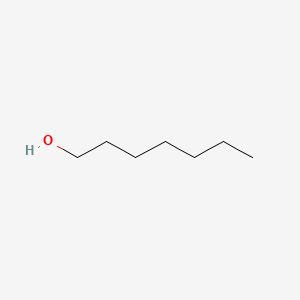| MeSH term | MeSH ID | Detail |
|---|---|---|
| Adenocarcinoma | D000230 | 166 associated lipids |
| Arrhythmias, Cardiac | D001145 | 42 associated lipids |
| Diabetes Mellitus, Experimental | D003921 | 85 associated lipids |
| Eye Burns | D005126 | 13 associated lipids |
| Cardiomegaly | D006332 | 31 associated lipids |
| Heart Injuries | D006335 | 6 associated lipids |
| Hypertension | D006973 | 115 associated lipids |
| Hypertension, Pulmonary | D006976 | 32 associated lipids |
| Neovascularization, Pathologic | D009389 | 39 associated lipids |
| Occupational Diseases | D009784 | 42 associated lipids |
n-heptanol
N-heptanol is a lipid of Fatty Acyls (FA) class. N-heptanol is associated with abnormalities such as Corneal Neovascularization. N-heptanol often locates in Epithelium and Structure of corneal epithelium. The related lipids are Heptanol.
Cross Reference
Introduction
To understand associated biological information of n-heptanol, we collected biological information of abnormalities, associated pathways, cellular/molecular locations, biological functions, related genes/proteins, lipids and common seen animal/experimental models with organized paragraphs from literatures.
What diseases are associated with n-heptanol?
n-heptanol is suspected in Corneal Neovascularization and other diseases in descending order of the highest number of associated sentences.
Related references are mostly published in these journals:
| Disease | Cross reference | Weighted score | Related literature |
|---|
Possible diseases from mapped MeSH terms on references
We collected disease MeSH terms mapped to the references associated with n-heptanol
PubChem Associated disorders and diseases
What pathways are associated with n-heptanol
There are no associated biomedical information in the current reference collection.
PubChem Biomolecular Interactions and Pathways
Link to PubChem Biomolecular Interactions and PathwaysWhat cellular locations are associated with n-heptanol?
Visualization in cellular structure
Associated locations are in red color. Not associated locations are in black.
Related references are published most in these journals:
| Location | Cross reference | Weighted score | Related literatures |
|---|
What functions are associated with n-heptanol?
There are no associated biomedical information in the current reference collection.
What lipids are associated with n-heptanol?
Related references are published most in these journals:
| Lipid concept | Cross reference | Weighted score | Related literatures |
|---|
What genes are associated with n-heptanol?
There are no associated biomedical information in the current reference collection.
What common seen animal models are associated with n-heptanol?
There are no associated biomedical information in the current reference collection.
NCBI Entrez Crosslinks
All references with n-heptanol
Download all related citations| Authors | Title | Published | Journal | PubMed Link |
|---|---|---|---|---|
| Omura M et al. | In situ Ca2+ imaging of odor responses in a coronal olfactory epithelium slice. | 2003 | Neuroreport | pmid:12821794 |
| Margineanu DG and Klitgaard H | Can gap-junction blockade preferentially inhibit neuronal hypersynchrony vs. excitability? | 2001 | Neuropharmacology | pmid:11522329 |
| Chen H et al. | Expressing exogenous functional odorant receptors in cultured olfactory sensory neurons. | 2008 | Neural Dev | pmid:18786248 |
| Olajos EJ et al. | Mutagenicity of alkyl-(omega-hydroxyalkyl) nitrosamines related to dibutylnitrosamine. | 1978 | Mutat. Res. | pmid:342939 |
| Martin FC and Handforth A | Carbenoxolone and mefloquine suppress tremor in the harmaline mouse model of essential tremor. | 2006 | Mov. Disord. | pmid:16773639 |
| Talarico EF | Plasma membrane calcium-ATPase isoform four distribution changes during corneal epithelial wound healing. | 2010 | Mol. Vis. | pmid:21139678 |
| Crooke A et al. | Silencing of P2Y2 receptor delays Ap4A-corneal re-epithelialization process. | 2009 | Mol. Vis. | pmid:19521552 |
| Coskun S and Lin YC | Effects of transforming growth factors and activin-A on in vitro porcine oocyte maturation. | 1994 | Mol. Reprod. Dev. | pmid:8080644 |
| Wood SC et al. | Channel inhibition by alkanols occurs at a binding site on the nicotinic acetylcholine receptor. | 1995 | Mol. Pharmacol. | pmid:7530805 |
| Furger C et al. | Human granulosa cells in culture exhibit functional cyclic AMP-regulated gap junctions. | 1996 | Mol. Hum. Reprod. | pmid:9239665 |
